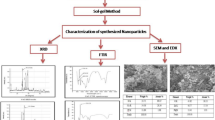Abstract
A glucose-reduced, room temperature-synthesized colloidal Cu2O solution (CCS) was used for the first time to detect humic acid (HA), a carcinogen-promoting substance in aqueous solution. The CCS sensor was characterized using standard spectroscopy and microscopy techniques. The sensor evolved as a carboxylic acid-capped peach-pink solution after synthesis. The result of the interaction of the sensor with HA in phosphate buffer solution (pH 7) showed a detection limit of 1.5891 × 10−2 mg/L over a concentration range of 0.00–0.41 mg/L. This finding suggests that the sensor may be useful for monitoring low levels of HA in aqueous environments.




Similar content being viewed by others
References
M.R. Jamalludin, Z. Harun, S.K. Hubadillah, H. Bari, A.F. Ismail, M.H.D. Othman, M.F. Shohur, and M.Z. Yunos: Antifouling polysulfone membranes blended with green SiO2 from rice husk ash (RHA) for humic acid. Chem. Eng. Res. Des. 114, 268–279 (2016).
N. Kawasaki, K. Matsushige, K. Komatsu, A. Kohzu, F.W. Nara, F. Ogishi, M. Yahata, H. Mikami, T. Goto, and A. Imai: Fast and precise method for HPLC-size exclusion chromatography with UV and TOC (NDIR) detection: importance of multiple detectors to evaluate the characteristics of dissolved organic matter. Water Res. 45, 6240–6248 (2011).
X. Qin, F. Liu, G. Wang, and L. Weng: Simultaneous analysis of small organic acids and humic acids using high performance size exclusion chromatography. J. Sep. Sci. 35, 345–3460 (2012).
C. Ma, M. Chen, H. Liu, K. Wu, H. He, and K. Wang: A rapid method for the detection of humic acid based on the poly(thymine)-templated copper nanoparticles. Chin. Chem. Lett. 29, 136–138 (2018).
S. Basumallick and S. Santra: Monitoring of ppm level humic acid in surface water using ZnO-chitosan nano-composite as fluorescence probe. Appl. Water Sci 7, 102–1031 (2017).
R.T. Lamar, C.O. Daniel, M. Lawrence, and R.B. Paul: A new standardized method for quantification of humic and fulvic acids in humic ores and commercial products. J. AOAC Int 97, 721–730 (2014).
A. Rodrigues, A. Brito, P. Janknecht, M.F. Proenca, and R. Nogueira: Quantification of humic acids in surface water: effects of divalent cations, pH, and filtration. J. Environ. Monit 11, 377–382 (2009).
X. Yuan, S. Yang, J. Fang, X. Wang, H. Ma, Z. Wang, R. Wang, and Y. Zhao: Interaction mechanism between antibiotics and humic acid by UV-Vis spectrometry. Int. J. Environ. Res. Public Health 15, 1–13 (2018).
A. Azzouz, K.Y. Goud, N. Raza, E. Ballesteros, S-E. Lee, J. Hong, A. Deep, and K-H Kim: Nanomaterial-based electrochemical sensors for the detection of neurochemicals in biological matrices. Trends Anal. Chem 110, 1–34 (2019).
M. Li, H. Gou, I. Al-Ogaidi, and N. Wu: Nanostructured sensors for detection of heavy metals: a review. ACS Sustain. Chem. Eng. 1, 713–723 (2013).
T. Gan, Z. Wang, J. Gao, J. Sun, K. Wu, and H. Wang: Morphology-dependent electrochemical activity of Cu2O polyhedrons and construction of sensor for simultaneous determination of phenolic compounds with gra-phene oxide as reinforcement. Sens. Actuators B 282, 549–558 (2019).
O.J. Fakayode, S.P. Songca, and O.S. Oluwafemi: Neutral red separation property of ultrasmall-gluconic acid capped superparamagnetic iron oxide nanoclusters coprecipitated with goethite and hematite. Sep. Purif. Technol. 192, 47–482 (2018).
O.J. Fakayode, S.P. Songca, and O.S. Oluwafemi: Singlet oxygen generation potential of thiolated methoxy- polyethyleneglycol encapsulated superparamagnetic iron oxide. Mater. Lett. 199, 37–40 (2017).
O.J. Fakayode, C.A. Kruger, S.P. Songca, H. Abrahamse, and O.S. Oluwafemi: Photodynamic therapy evaluation of methoxypolyethylenegly-col-thiol-SPIONs-gold-meso-tetrakis (4-hydroxyphenyl) porphyrin conjugate against breast cancer cells. Mater. Sci. Eng. C 92, 737–744 (2018).
S.A. Singh, S. Mukherjee, and G. Madras: Role of CO2 methanation into the kinetics of preferential CO oxidation on Cu/Co3O4. Mol. Catal. 466, 167–180 (2019).
H. Manisha, P.D. Priya Swetha, Y-B. Shim, and K.S. Prasad: Microwave assisted synthesis of hybrid Cu2O microcubes for photocatalysis and electrocatalysis. Mater. Today: Proc 5, 16390–16393 (2018).
M. Balık, V. Bulut, and I.Y. Erdogan: Optical, structural and phase transition properties of Cu2O, CuO and Cu2O/CuO: their photoelectrochemical sensor applications. Int. J. Hydrogen Energy 44, 18744–18755 (2018).
H. Zhu, Y. Li, and X. Jiang: Room-temperature synthesis of cuprous oxide and its heterogeneous nanostructures for photocatalytic applications. J. Alloys Compd. 772, 447–459 (2019).
A. Kerour, S. Boudjadar, R. Bourzami, and B. Allouche: Eco-friendly synthesis of cuprous oxide (Cu2O) nanoparticles and improvement of their solar photocatalytic activities. J. Solid State Chem. 263, 79–83 (2018).
O.J. Fakayode, N. Tsolekile, S.P. Songca, and O.S. Oluwafemi: Applications of functionalized nanomaterials in photodynamic therapy. Biophys. Rev. 10, 49–67 (2018).
V.S. Kumar and S. Ganesan: Preparation and characterization of gold nanoparticles with different capping agents. Int. J. Green Nanotechnol. 3, 47–55 (2011).
O. Novotný, K. Cejpek, and J. Velíšek: Formation of carboxylic acids during degradation of monosaccharides. Czech J. Food Sci. 26, 117–131 (2008).
A. Paucean, D.C. Vodnar, V. Muresan, F. Fetea, F. Ranga, S.M. Man, S. Muste, and C. Socaciu: Monitoring lactic acid concentration by infrared spectroscopy: a new developed method for Lactobacillus fermenting media with potential food applications. Acta Aliment. 46, 420–427 (2017).
E. Cheraghipour, S. Javadpour, and A.R. Mehdizadeh: Citrate capped superparamagnetic iron oxide nanoparticles used for hyperthermia therapy. J. Biomed. Sci. Eng. 5, 71–719 (2012).
X. Cheng, L. Zhao, X. Wang, and J. Lin: Sensitive monitoring of humic acid in various aquatic environments with acidic cerium chemilumines-cence detection. Anal. Sci. 23, 1189–1193 (2007).
I. Tarhan and H. Kara: A chemometric study: automated flow injection analysis method for the quantitative determination of humic acid in Ilgin lignite. Arab. J. Chem. 9, 713–720 (2016).
X. Cui and K-H. Choo: Natural organic matter removal and fouling control in low-pressure membrane filtration for water treatment. Environ. Eng. Res 19, 1–8 (2014).
X. Zhang, L. Fan, and F.A. Roddick: Impact of the interaction between aquatic humic substances and algal organic matter on the fouling of a ceramic microfiltration membrane. Membranes 8, 1–10 (2018).
W. Zhang and B. Jia: Toward antifouling capacitive deionization by using visible-light reduced TiO2/graphene nanocomposites. MRS Commun. 5, 613–617 (2015).
H. Younas, J. Shao, Y. He, G. Fatima, S.T.A. Jaffar, and Z.U.R. Afridi: Fouling-free ultrafiltration for humic acid removal. RSC Adv. 8, 24961–24969 (2018).
ACKNOWLEDGMENTS
The authors are grateful to the Nanotechnology and Water Sustainability Research Unit (NanoWS) of the University of South Africa (UNISA) for the resource and financial supports.
Author information
Authors and Affiliations
Corresponding author
Rights and permissions
About this article
Cite this article
Fakayode, O.J., Adekunle, A.S. & Nkambule, T.T.I. Detection of low-level humic acid in water using room temperature-synthesized copper (I) oxide colloids. MRS Communications 9, 1317–1322 (2019). https://doi.org/10.1557/mrc.2019.128
Received:
Accepted:
Published:
Issue Date:
DOI: https://doi.org/10.1557/mrc.2019.128




